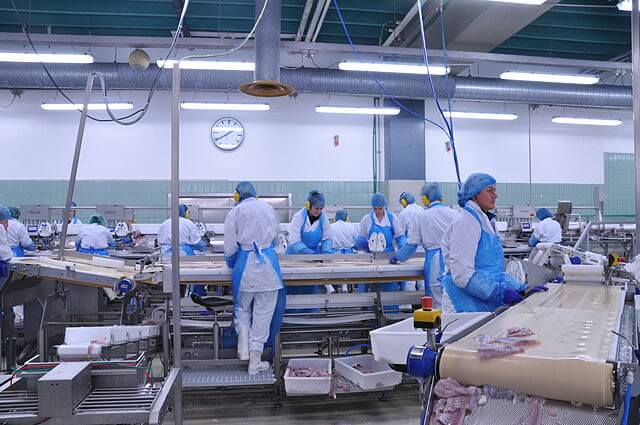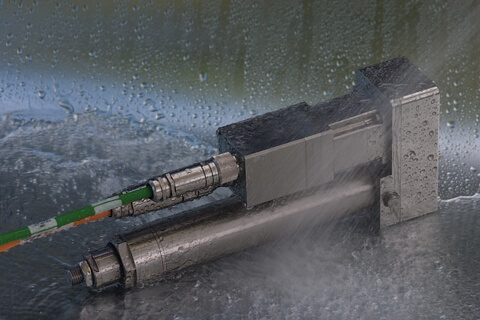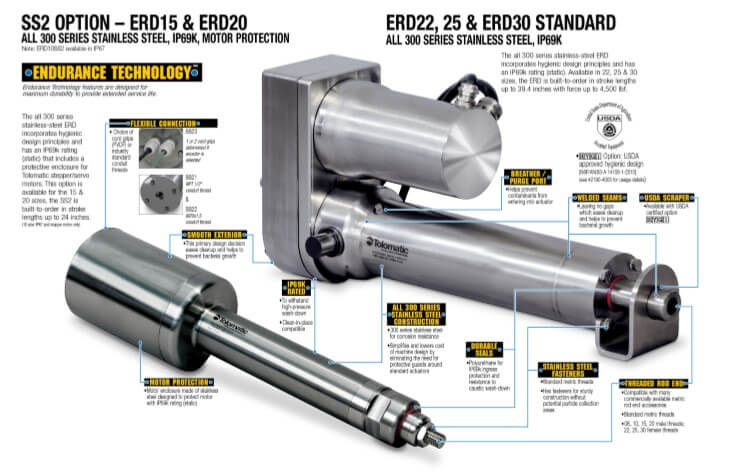Linear actuators help prevent food contamination
By Tolomatic on April 5, 2016
 Until recently, the food processing industry has handled contamination reactively. If a foodborne illness was traced back to contamination at a manufacturing plant, the FDA (Food and Drug Administration) had the manufacturer fix the problem.
Until recently, the food processing industry has handled contamination reactively. If a foodborne illness was traced back to contamination at a manufacturing plant, the FDA (Food and Drug Administration) had the manufacturer fix the problem.
The flaw in this system, though, was that most of these illnesses were preventable. The Centers for Disease Control and Prevention estimates that 48 million people (1 in 6 Americans) get sick, 128,000 are hospitalized, and 3,000 die each year from foodborne diseases. That makes food contamination a major public health issue.
The federal government stepped in to change the way the FDA and food producers operate with the Food Safety Modernization Act (FSMA) – signed into law in January 2011. This important legislation shifts the focus to preventing contamination problems instead of just responding to them. FSMA affects all automation components used in the industry, including linear actuators.
FSMA implementation is moving forward, and food producers are making changes to their operations to meet the legislation’s requirements. As an active participant in the food and beverage industry, we’re evolving our product offering to meet the needs of food producers.
Linear actuators are important components in many food processing systems. We’ve documented the critical factors to consider when selecting linear actuators for food and beverage processing in our white paper. Click here to get your copy.
What’s new with the FSMA
The most significant FSMA advance is that final rules have been issued. These final rules include
- Standards for the Growing, Harvesting, Packing, and Holding of Produce for Human Consumption
- Current Good Manufacturing Practice and Hazard Analysis and Risk-Based Preventive Controls for Human Food
- Current Good Manufacturing Practice and Hazard Analysis and Risk-Based Preventive Controls for Food for Animals
- Sanitary Transportation of Human and Animal Food
Now compliance with FSMA rules is at the forefront for producers. September 19, 2016 is the deadline for food companies that aren’t considered small businesses to comply with FSMA Hazard Analysis and Risk-Based Preventive Controls (HARPC).
The first step in meeting HARPC requirements is to establish a food safety plan that
- Identifies hazards in the food handled at the facility (biological, chemical, and physical hazards)
- Implements preventive controls
- Develops effective monitoring procedures for the controls
- Establishes corrective actions for when controls are ineffective
- Validates the controls, monitoring, and corrective actions
- Establishes a recall plan
- Sets up a supply chain program
- Includes re-analysis of the plan at least once every three years
The FSMA Technical Assistance Network (TAN) is now available by email or surface mail to answer producers’ questions. Questions submitted to the TAN will be answered by FDA Information Specialists or Subject Matter Experts. The FDA promises to respond as soon as possible, although response times may vary due to a question’s complexity or the volume of inquiries.
Processing equipment and food safety
A food safety plan’s hazard evaluation includes the production facility and equipment and considers whether equipment or procedures could introduce a hazard into foods. For example:
- Does the design of production equipment eliminate all possible sources of contamination? Equipment that relies on metal-to-metal contact to function may generate metal fragments that could adulterate the food.
- Is equipment designed so it can be thoroughly sanitized? Equipment that is difficult to clean, with niches, rough edges or close-fitting parts, can permit disease-causing microbes to grow and contaminate food.
 An engineer can mitigate hazards by choosing the right equipment. Thorough equipment cleaning (washdown with water, steam and even caustic solutions) is often used to eliminate potential contamination, so engineers should carefully evaluate production equipment for its ability to withstand these procedures and any corrosive substances used. Factors to look for include:
An engineer can mitigate hazards by choosing the right equipment. Thorough equipment cleaning (washdown with water, steam and even caustic solutions) is often used to eliminate potential contamination, so engineers should carefully evaluate production equipment for its ability to withstand these procedures and any corrosive substances used. Factors to look for include:
- A design that sheds moisture
- Use of materials that resist corrosion, including fasteners, seals, and gaskets
- Use of food-safe materials
- Protection of vital components from moisture and corrosion
Linear actuators meet food safety needs
Linear actuators, as key automation components in food manufacturing, are affected by FSMA. They either must withstand caustic washdowns (and be clean-in-place compliant) or be shielded from microbial contamination and cleaning processes. It’s usually better to specify clean-in-place compliant actuators since shielding adds cost and complexity to a machine’s design,
Engineers serving this industry should look for stainless steel housings and fasteners, motor enclosures, corrosion-resistant seals, water-shedding designs, and an IP69K rating when selecting linear actuators for washdown environments.
Tolomatic offers ERD IP69K electric cylinders in a range of sizes and models. ERD electric rod actuators are designed to withstand the rigors of food manufacturing, even harsh washdowns. The SS2 (15 and 20) and USDA approved (22, 25 and 30) models are clean-in-place compliant. They streamline a machine’s design by eliminating shielding.
Learn more
Download our white paper: Evaluating actuators for washdown in food and beverage applications.

 Ask an Engineer
Ask an Engineer